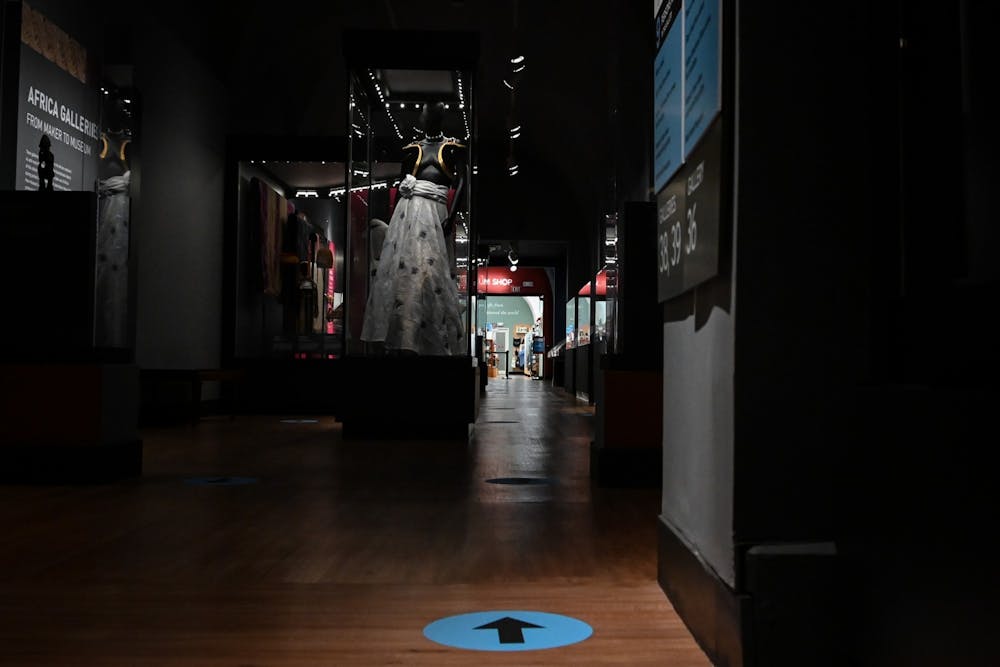
The Penn Museum recently reopened its doors to the public at limited capacity.
Credit: Kylie CooperPenn Museum unveiled a new exhibition to bring people behind the scenes of the archaeological process at the University.
The exhibition, titled “Invisible Beauty: The Art of Archaeological Science,” opened on Jan. 16, just days after the Penn Museum reopened its doors to the public amid the COVID-19 pandemic. Compared to the typical Penn Museum displays, which focus on objects, this exhibition centers around images revealing information that would otherwise be hidden. The show is scheduled to run through June 6.
The displays showcase many different objects from Penn's laboratories, covering a vast timespan. The exhibition houses both a Neanderthal tooth from 40,000 BCE and a ceramic cooking pot from 1967. The pieces come from as far as Asia to as local as West Philadelphia, and range in size from a single cell diatom to expansive subsurface features of landscapes.
The images, generated using techniques such as microscopy and infrared light imaging, are paired with the objects they were taken from, such as ceramics, metals, and stones.
Invisible Beauty also displays the process of conducting archaeological research, allowing visitors to understand the elements of producing and analyzing the images on display in Penn Museum, said co-curator Marie-Claude Boileau.
“We’re really showing what happens in the laboratory, behind the scenes in our spaces, how we actually acquire information, and how we answer specific questions about the past,” Boileau said. “We’re showing our visitors what we do on a daily basis.”
The exhibition was inspired by a student researcher who was showing co-curator Sarah Linn microscopic images of various metals that she had generated.
“I was just really struck by how aesthetically beautiful these images were,” Linn said. “That’s really what started this.”
In addition to selecting visually appealing pieces for Invisible Beauty, the curators and colleagues also wanted to choose images that “tell really good stories,” Linn said.
Boileau said the exhibit came together through knowledge of history, as well as tools borrowed from the hard sciences.
COVID-19 also played a critical role in shaping the exhibition, as a large part of its planning and layout was completed remotely. Because of the pandemic, all of the pieces showcased in Invisible Beauty are from Penn's laboratories, challenging a common perception of archaeology, Linn said.
“Most people, when they picture archaeologists, they think of us in the field excavating – in often faraway places – and we’re not traveling right now at all,” she said. “This is shining a light on what we can do with the material that we have.”
Adapting to the online environment, Penn Museum released virtual programming so that members of the community could continue to utilize its offerings remotely. The programming, named “Penn Museum at Home,” includes digital images, virtual gallery tours, and live events. Linn and Boileau said they hope to create a virtual gallery of Invisible Beauty for those who are not able to attend the gallery in-person.
“As much as it’s a shame to not be in the space, it’s also great that we can reach a larger audience,” Linn said.
Despite closing in March due to the pandemic, Penn Museum was able to welcome visitors from late July to November. It closed again around Thanksgiving because of new citywide public health guidelines, but recently reopened on Jan. 8. Penn Museum is operating in accordance with COVID-19 safety protocols, requiring masks and social distancing, as well as providing styluses for all visitors to interact with digital displays.
Penn Museum Public Relations Director Jill DiSanto encouraged all Penn students to visit the Invisible Beauty gallery at Penn Museum over the coming months.
“We’re showcasing the work that students are doing in our labs,” DiSanto said. “That reflects the rich academic experience students get at Penn.”
The Daily Pennsylvanian is an independent, student-run newspaper. Please consider making a donation to support the coverage that shapes the University. Your generosity ensures a future of strong journalism at Penn.
Donate







